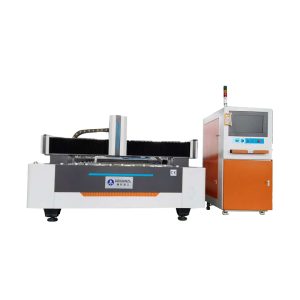Introduction
Laser cutting technology has revolutionized the manufacturing industry, offering precise and efficient cutting solutions. Two popular types of laser cutting machines are CO2 laser cutting machines and fiber laser cutting machines. While both utilize laser technology, they differ in terms of their operation, capabilities, and suitability for various applications.

1.Operation
CO2 Laser Cutting Machine:
CO2 lasers generate laser beams using a gas mixture, typically consisting of carbon dioxide, nitrogen, and helium.
The laser beam is reflected by mirrors and directed through a focusing lens onto the material, resulting in melting or vaporization at the point of contact.
CO2 lasers are considered “slow-flow” lasers, meaning they require continuous gas flow to maintain optimal performance.
Fiber Laser Cutting Machine:
Fiber lasers use an active fiber doped with rare earth elements such as erbium, ytterbium, or neodymium.
The laser beam is transmitted through a flexible fiber optic cable and delivered to the cutting head, where it is focused onto the material.
Fiber lasers have a higher power density compared to CO2 lasers, allowing for faster cutting speeds and increased precision.
2.Cutting Capabilities
Material Compatibility:
CO2 Laser Cutting Machine: Well-suited for cutting non-metallic materials such as wood, acrylic, leather, and fabric.
Fiber Laser Cutting Machine: Primarily designed for metal cutting, including stainless steel, mild steel, aluminum, copper, and brass.
Thickness Range:
CO2 Laser Cutting Machine: Ideal for thinner material sheets up to 25mm, but may struggle with thicker metals due to limited power density.
Fiber Laser Cutting Machine: Capable of cutting a wide range of metal thicknesses, ranging from thin foils to thick sheets exceeding 25mm, thanks to higher power density.
3.Advantages and Disadvantages
CO2 Laser Cutting Machine:
Advantages: Versatile for non-metallic materials, precise cutting quality, lower cost compared to fiber lasers.
Disadvantages: Limited suitability for metal cutting, slower processing speeds.
Fiber Laser Cutting Machine:
Advantages: High-speed cutting, excellent precision on metal materials, efficient energy usage, low maintenance requirements.
Disadvantages: Higher equipment cost, limited compatibility with non-metallic materials.
4.Applications
CO2 Laser Cutting Machine:
Signage and advertising industry, packaging and printing industry, textile and apparel sector, architectural model making, artistic and decorative crafts.
Fiber Laser Cutting Machine:
Automotive and aerospace industries, metal fabrication, electrical enclosures manufacturing, jewelry production, medical device manufacturing.
Conclusion
CO2 laser cutting machines and fiber laser cutting machines offer distinct advantages and are designed for different purposes. CO2 lasers excel in non-metallic materials, while fiber lasers dominate the metal cutting arena with their speed and precision. Understanding the differences between these two types of laser cutting machines is essential in selecting the most suitable technology for specific applications, ensuring optimal productivity and quality in the manufacturing process.

